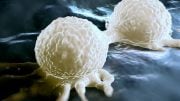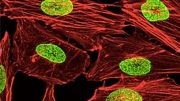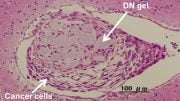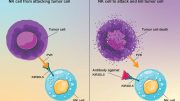
The team plans to use their new approach to study different cell types and discover chemical compounds that impinge upon any readout in the future.
Scripps Research scientists are able to pinpoint potential new drug targets by analyzing the effects of mirror image versions of small molecules on clusters of proteins.
Scientists from Scripps Research Institute have devised an innovative technique to identify small molecules capable of modifying protein functions, paving the way for targeted drug discovery. Working alongside researchers from other institutions, the team employed their novel method to detect small molecules that can influence the activity of cancer-related proteins.
The findings, published in the journal Molecular Cell, enhance prior methods that only screened for the selective binding of small molecules to proteins, without determining their impact on the proteins’ biological functions. The updated approach involves employing two mirror-image versions of a small molecule and analyzing the alterations they cause in the size of protein complexes within cells.
“The ability of small molecules to specifically bind to a protein and cause a biological consequence is the fundamental basis for most drugs today,” says senior author Benjamin Cravatt, Ph.D., Gilula Chair of Chemical Biology at Scripps Research. “With this assay, we’re expanding our ability to discover these small molecules that not only bind proteins, but have functional impacts.”
In recent years, Cravatt’s lab has designed sets of small chemicals that can irreversibly bind to certain parts of proteins. However, screening these chemical libraries to discover their possible impact on protein function was generally a slow and tedious process. Since individual proteins have different roles in cell biology, researchers often have to develop specialized functional screens for each protein of interest. One screen, for instance, might determine whether the chemicals affected cell growth, while another might determine whether the chemicals changed levels of a different molecule.
“Just because a small molecule engages a protein physically doesn’t mean that it changes the protein’s function in the cell,” says co-first author Jarrett Remsberg, Ph.D., who carried out the work as an American Cancer Society postdoctoral research fellow in the Cravatt lab at Scripps Research. Former graduate student Michael Lazear, Ph.D., and postdoctoral fellow Martin Jaeger, Ph.D. were also first authors of the paper.
In the new work, Cravatt’s group used the conglomeration of proteins into complexes as a proxy for their function. Proteins often work by binding to other proteins—if this binding doesn’t happen or if it is induced to happen, it indicates a protein’s function may have changed.
The research team designed pairs of “mirror image” molecules, called stereoisomers, that could each bind irreversibly to proteins in the same way that their previous chemical libraries had worked. The pairs of stereoisomers let them be sure that the impact of each small molecule was due to its unique structure (if only one version of a molecule changes the proteins’ function, it is likely a specific and direct interaction). Once they exposed cells to the pairs of stereoisomers, they tested whether a protein-of-interest was in a different size complex, using a technique called size exclusion chromatography in which proteins are sifted through beads with different-sized pores.
To show the utility of this approach, the researchers screened the set of small molecules for their ability to change the sizes of protein complexes in prostate cancer cells. They pinpointed a molecule, MY-1B, which selectively disrupted a complex of proteins known as PA28, previously found to play a role in degrading proteins in cancer. Further work in leukemia cells confirmed that, by specifically binding to the protein PMSE1, MY-1B or a related compound (but not their mirror images) could effectively inactivate the PA28 complex.
Cravatt and colleagues also followed up on an observation that a different chemical, EV-96, changed the size of a protein complex involved in splicing strands of RNA inside cells. The team discovered that EV-96 slowed the growth of cancer cells and pinpointed SF3B1 as the protein the chemical was binding to.
In both cases, the new chemicals represent the first time scientists have been able to target the protein complexes— PA28 and the so-called spliceosome— with small, simple synthetic chemicals.
“This means that researchers have new chemical tools in their arsenal that they didn’t have before,” says Remsberg. “It’s an opportunity for better understanding these proteins as well as investigating potential therapeutic opportunities.”
The team hopes their approach can be expanded to use other functional readouts than complex size, and they intend to use it to study different cell types in the future.
“The long-term idea is that we can use this approach to discover chemical compounds that impinge upon any readout,” says Cravatt. “There are certainly other readouts that we hope to be able to look at in the future.”
Enter your journal: Reference: “Proteomic discovery of chemical probes that perturb protein complexes in human cells” by Michael R. Lazear, Jarrett R. Remsberg, Martin G. Jaeger, Katherine Rothamel, Hsuan-lin Her, Kristen E. DeMeester, Evert Njomen, Simon J. Hogg, Jahan Rahman, Landon R. Whitby, Sang Joon Won, Michael A. Schafroth, Daisuke Ogasawara, Minoru Yokoyama, Garrett L. Lindsey, Haoxin Li, Jason Germain, Sabrina Barbas, Joan Vaughan, Thomas W. Hanigan and Benjamin F. Cravatt, 20 April 2023, Molecular Cell.
DOI: 10.1016/j.molcel.2023.03.026
In addition to Cravatt, Remsberg, Lazear and Jaeger, authors of the study, “Proteomic discovery of chemical probes that perturb protein complexes in human cells” are Kristen E. DeMeester, Evert Njomen, Sang Joon Won, Michael A. Schafroth, Daisuke Ogasawara, Minoru Yokoyama, Garrett L. Lindsey, Haoxin Li, Jason Germain, Sabrina Barbas, Thomas W. Hanigan, Vincent F. Vartabedian, Christopher J. Reinhardt, Melissa M. Dix, John R. Teijaro and Bruno Melillo of Scripps; Katherine Rothamel, Hsuan-lin Her and Gene W. Yeo of UC San Diego; Simon J. Hogg, Jahan Rahman and Omar Abdel-Wahab of Memorial Sloan Kettering Cancer Center; Landon R. Whitby and Gabriel M. Simon of Vividion Therapeutics; Joan Vaughan and Alan Saghatelian of The Salk Institute; Seong Joo Koo, Inha Heo, Brahma Ghosh, and Kay Ahn of Janssen Research and Development; and Stuart L. Schreiber of Harvard University and the Broad Institute.
The study was funded by the National Institutes of Health, American Cancer Society, Vividion Therapeutics, Janssen Pharmaceuticals, Pfizer, an EMBO long-term fellowship, a Jane Coffin Childs Memorial Fellowship, an HHMI Hanna H Gray Fellowship, a JSPS overseas research fellowship, an Allen Distinguished Investigator Award, and a Paul G. Allen Frontiers Group advised grant of the Paul G. Allen Foundation.









Be the first to comment on "“Mirror-Image” Molecules Open the Door to Better Cancer Treatments"